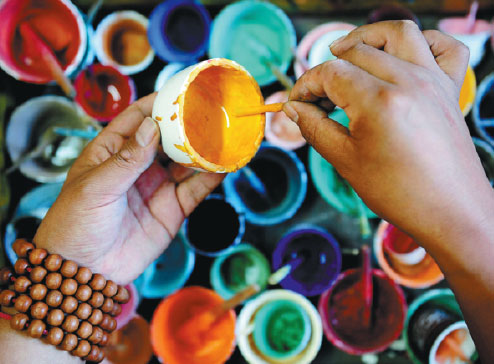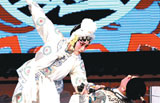Pigment producers push to protect ancient art
Updated: 2015-07-16 07:51
By Palden Nyima(China Daily)
|
|||||||||||
 |
|
A thangka artist creates a variety of hues using mineral pigments. [Photo/Xinhua] |
Tibetan mineral pigments are of such high quality that they will retain their color for more than 200 years. In extreme cases, some pigments will remain pristine for as long as a millennium.
The production process for mineral pigments is far more difficult than that used to make other pigments, and as a consequence, they are much more expensive.
A variety of pigment-bearing minerals can be ground into fine powders to produce five basic colors - green, blue, red, yellow and white - which are then divided further into hues.
The pigments are all extracted from ore stones. White stones come from Rinbung county, while the other colors are found in different parts of the region, such as Nyemo county, Qamdo city, and even in the Diqing Tibetan autonomous prefecture in Yunnan province.
Penpa's colleague Samdrub said his team only uses mineral pigments, because colors in non-mineral pigments produced outside Tibet fade quickly.
Ageless beauty
"Tibetan mineral pigments will remain bright and unfaded for more than 200 years, sometimes as long as 1,000 years," Samdrub said.
"The pigments produced at lower altitudes cannot endure the harsh conditions in Tibet, such as the intense ultraviolet light and strong winds," the 50-year-old added.
He said the company has eradicated the sale of counterfeit or low-quality products. "Instead of cheating people, it's important to show them different products at different prices. If people cannot afford to buy artifacts made with mineral pigments, there are always alternatives, such as thangkas produced using pigments produced in other places in China and in India," Samdrub said.
Only four companies in China produce genuine Tibetan mineral pigments - unsurprisingly three of them are situated in Tibet, while the other is in Beijing.
Today's Top News
France returns 32 cultural relics to Chinese museum
Mayor to turn Zhanjiang into green economic powerhouse
Private firms' access to arms sector widens
Warren Buffett, Johnny Depp buy Greek islands
China, World Bank pledge $50m for poor
Web companies asked to support 'digital Silk Road': Zhanjiang forum
Risks growing for cybersecurity
China's stock wobbles may deter foreign investors - for now
Hot Topics
Lunar probe , China growth forecasts, Emission rules get tougher, China seen through 'colored lens', International board,
Editor's Picks

|

|

|

|

|

|






